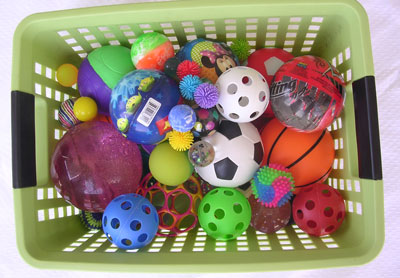Blog
Time to Play with our Holiday Toys!!!
2 Simple and Easy Toys for Speech and Language Development in Children
So the holidays are over, and you have a bunch of toys and gift cards! That can only mean one thing…. IT’S TIME TO PLAY!!! Below I discuss how two basic toys (a doll and some balls) can be used to facilitate language and benefit your child!
“The playing adult steps sideward into another reality; the playing child advances forward to new stages of mastery.” – Erik H. Erikson

A Baby Doll is an extremely beneficial and fun way to facilitate language in all children. Here are some ways to use a baby doll to for language purposes.
- Body Parts– (eyes, nose, ears, mouth, hands, fingers, feet, toes, etc.). To target receptive language start by having your child locate the doll’s body part, in which you give a verbal command. For instance, “Show me the dolls eyes.” Eventually you can relate this to your child’s own body parts, “Show me YOUR eyes.” Additionally, you can incorporate following directions; “Touch the dolls nose, and then touch her ears.” To target expressive language, have the child verbally say the name of each body part you point to.
- Basic Concepts/ Everyday Tasks– Work on everyday concepts using prepositions. For example, “Put the baby ON the bed,” or “Put the baby UNDER the blanket.”
- Facilitate Vocabulary– Work with your child on expanding his/her vocabulary through use of verbs. As you play with the doll use self-talk. For example, “Look at me, I’m feeding the baby she looks hungry!” You can use words such as “Up, down, sit, stand, sleep, tired, drink, feed, eat”
- Social/Pragmatic Skills– Together you and your child can act as if the baby is real. Allow the child to take the doll around the house. Make the doll some real for the day! Have your child wash and feed the baby. Talk about what you’re doing each step of the way.

Balls– Balls are another fun way to use play to facilitate language.
- Problem Solving/Counting– See which ball can fit in which container. You can use basic Tupperware or jars from around the house. Play with your child and see which fits and which doesn’t allow them to explore and manipulate the items. Count at the balls with your child. Let them hear you counting for a few times, and then encourage them to join in.
- Color/Size– Buy different color balls. Go over with your child all the different colors. Maybe sing a song related to the colors of the balls- make it FUN! Use a bunch of different balls and point out the extremes. “Wow this is the SMALLEST ball, and this is the BIGGEST ball.” As your child begins to understand as your child “Can you bring me the SMALLEST ball?”
- Vocabulary– Talk about the balls. Are they hard? Soft? Heavy? Light? Big? Small?
- Social Skills– Practice turn taking skills with your child. Allow them to request which ball they want to play with. A great way to target turn taking is through play! Play catch, roll the ball back and forth, and take turns hiding/seeking the ball. This requires the child to pay attention and focus on the task at hand. The child is required to wait patiently for his/her turn and begin to read nonverbal cues.
- Make Silly Jokes– When playing with your child “accidently” mess up and really exaggerate it, see if your child catches on! For instance, when handing him/her the ball say “Here is the PURPLE ball (when really it is an orange ball).” This is a fun way for the child to correct YOU. It will allow you to see if your child is understanding the concept and paying attention.
Pamela Leibowitz MA- CF-SLP TSSLD




